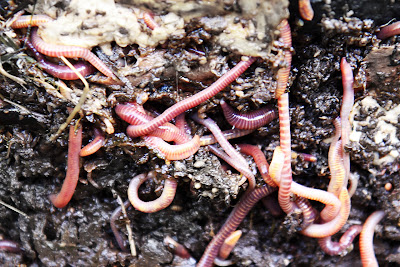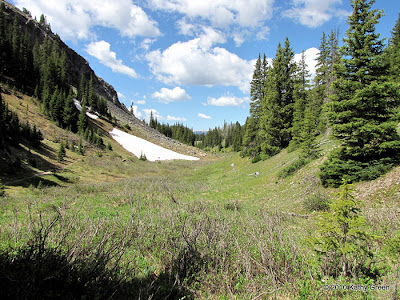Earthworms are Nature's Best Rototillers
We as gardeners like to think that everything we do in the gardens to "help them" are a positive and necessary part of gardening. Sometimes misconceptions occur regarding what is best for the gardens. This is usually due to old or outdated research, wives tales, agricultural and gardening history, or fancy advertising and sales pitches. So, how much cleanup does a garden really need? Much less than you might think.
First, there is the question on whether or not to till a garden. My firm answer to that is "not on a yearly basis, if ever." Tilling the soil does much more harm than good, especially in an organic garden. Every time you till the soil, you destroy millions and millions of tiny organisms, air pockets, and soil structure. Not to mention worms, worm tunnels, and other beneficial insects that live beneath the crust of your soil. So, unless you are building a brand new garden and need to till in compost and/or amendments to initially enrich the soil, leave the rototiller in the shed. And, if you use the layering method of building a garden then you never have to till. Mother Nature never uses a rototiller, and look at how well everything grows in a forest or a meadow. Worms and other insects move the dead plant materials into the earth all by themselves, and they do a fantastic job at it.
You might be asking yourself, then why are fields and vegetable gardens tilled every year? The answer to that is because crops and veggies use up a lot of fertilizer and nutrients in order to produce abundant yields. So, over the years the farmers and backyard vegetable growers have replaced the depleted nutrients with lots of artificial fertilizers, killed the weeds with lots of artificial herbicides, and gotten rid of all the "pests" with lots of artificial insecticides. After doing all of this to the earth, there is little if any organic structure or "soil web" left. It is a vicious cycle, and takes time to heal. Since most people want yearly yields from their plots, more fertilizer is tilled into the soil, and the inorganic cycle continues.
Getting these gardens ready will mean taking out the hoops and cleaning out the plant material, that's it.
So, if you don't have to till, then how about the rest of the garden cleanup? Well, it depends on what type of garden and how pristine you think your gardens should look in the off season. Vegetable gardens should be cleaned out by removing dead plant material and putting it in the compost pile. If the plant is diseased, then you must either hot compost the plant, or put it in the trash. When you pull out the dead plants, try not to disturb the rest of the soil. That way, weed seeds don't have a chance to get embedded in the soil, and the topsoil does not blow away as easily. If you have some compost that is ready for the gardens, put a 2 to 3 inch layer on the top of the soil, and call it good. By springtime the compost's nutrients will be working their way down into the soil.
Annual flowers, both in pots and garden beds, should be pulled out and put in the compost pile. They have lived their short lives to the fullest, and now can give something back to the earth. If you have some self-seeding annuals that you want to leave, that's great. You can let the seeds fall over the winter, and then just take out the plant in the springtime.
Leaving the Avalanche Feather Reed grasses till springtime means stunning frosted blades and seed heads
Finally, perennials and ornamental grasses don't really need to be cut to the ground in the fall. Many of them look great with snow or frost, and many more will actually do better when not cut back until springtime. And a lot of their leaves will decompose over the winter, leaving nutrients on the soil to be carried underground by the many beneficial insects you hardly ever see. They include ants, worms, beetles, centipedes and millipedes, pillbugs and sowbugs, and springtails. By leaving "food" for them, you provide food for the soil and the earth.
The rudbeckia look great when left for the winter






You just saved me a ton of work. Thanks! I always thought you had to cut back Perennials before winter and that is what I have been up to lately. I was down to one last bed and today was the day to tackle it before the snow comes again. ( I so did not want to trash my knees again.) So, now that I read this great post, I feel inclined to sit back and let nature do it's job. Thanks, Kathy!
ReplyDeleteRosey
Kathy, so very true. Allowing some of the pennials to stand can also give cover for overwintering birds. Great post.
ReplyDeleteScott
All excellent advice, and told in a warm, soothing voice. As a fellow Wormlover, I salute you.
ReplyDeleteReally informative post! I love earthworms.
ReplyDeleteThis is great information and I have to come back and read more. I didn't cut down the grasses along our pond last year and they served as a place for birds to hide. The bird feeder area gets scoped out by coopers and sharp-shinned hawks during the winter. My goal is to take our yard and make it as wildlife friendly as possible and to get out front yard away from the suburban green grass concept. I grabbed a lawn-reform widget and I already have a wildlife certified habitat, but I am not a garder, but am eager to learn.. Michelle
ReplyDeleteWhat a great, informative post. Personally, I prefer layering compost around existing plants and leaving the soil underneath alone.
ReplyDeleteEarthworms are irreplaceable in the garden, but they sure are ugly....
Great post Kathy. I need to send some of my fellow MG'ers over here since you said it better than I do. :-) I love your frost photos.
ReplyDeleteThanks for all of the great feedback.
ReplyDeleteScott and Liz, good point about the birds, they do tend to eat the seedheads here.
Rosey, glad to have saved your knees. I do cut down my lily stalks in the fall, so as not to let rot get down to the bulbs, but other than that, the rest of my perennials stand "tall" over winter.
And to the rest of you earthworm lovers, I am so glad to see that others like the wrigglers as much as I do.
Kathy
Hi, Kathy;
ReplyDeleteLove that Rudbeckia frosty photo! I leave as much as I can for winter interest. I kind of like the 'ragged' look of my garden when the snows are blowing. :)
This is really a great post. So many people believe that everything must be clean and tidy before the winter, and I never have. As for my little community plot, if I never have to turn the soil again, well that is wonderful.
ReplyDeleteSee even seasoned gardeners can learn something new.
Thanks for visiting my blog, and the fave on Blotanical. Much appreciated!
Looking forward to seeing much more of your blog in the future.
Jen